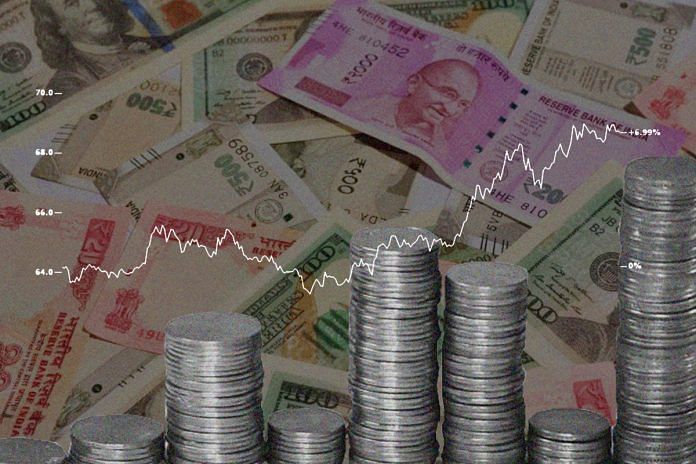The Indian rupee has seen a steady slide over the last one month, which has led to uncertainty in the economy.
Currency experts say the rupee is expected to breach the 70-to-a-dollar mark in the next six to eight months.
ThePrint asks – Can India afford the rupee crossing the 70 mark or should the RBI boost the currency?
RBI has instruments to prevent sharp depreciation of rupee, but these have economic costs
 Saugata Bhattacharya
Saugata Bhattacharya
Chief Economist, Axis Bank
A currency is a good summary indicator of foreign investors’ perception of the nation’s economic health. The currency will strengthen if a country has a trade surplus, which might be a sign of economic competitiveness, or if foreign capital flows are high, usually indicating investor confidence in a country’s growth. Since 2014, the rupee has been one of the most stable and best performing emerging markets’ currencies. However, of late, the rupee has depreciated against the US dollar more than many of its Asian peers.
The RBI has indeed intervened heavily in the currency markets over the past few months. Was this intervention necessary, and what objectives, if any, did it achieve? Should it have let the rupee depreciate freely?
In theory, a depreciating currency is meant to increase a country’s competitiveness relative to its peers, thereby helping it to boost exports, which is a growth driver. However, it also has negative effects, including reducing foreign capital inflows (which India dearly needs), raising the vulnerability of its external debt repayments, and increasing imported inflation.
In my opinion, a falling exchange rate does little to help boost exports but instead activates concerns about economic fundamentals. The RBI has enough instruments to prevent a sharp depreciation, but these have economic costs and therefore cannot be used indefinitely. The effect of the recent intervention, for instance, has been more to smooth out the high volatility of the rupee rather than move it significantly in any direction. Ultimately, it is a country’s economic fundamentals and policies, which will determine its currency, not the other way around.
Rupee should be allowed to go where it’s going, intervention must only curb volatility
 D.K. Joshi
D.K. Joshi
Chief economist, Crisil
There has been a lot of discussion about the rupee and what its value should be. The rupee should be allowed to go where it is going. Any intervention should only curb volatility. Authorities should actually be focused on arresting volatility and maintaining healthy macroeconomic fundamentals.
The global vulnerability and uncertainties have collectively impacted the rupee. India’s macroeconomic fundamentals are much stronger than what they were five years ago, and therefore are less vulnerable although possibilities and quantum of global shocks are much higher.
The oil shock has been the least complex of global shocks India is facing, but has had the most perceptible impact on the current account deficit and inflation.
The other two shocks – monetary policy normalisation in advanced countries and intensification of trade wars – take us into unchartered territory. Therefore, volatility has become the only certainty.
All these are impacting the global markets and currencies. Over the past few months, foreign investors have fled debt and equities, and precipitated a fall in the rupee, going with the trend in other emerging markets. Authorities need to keep a constant eye on these developments and must be able to take measures as and when required to reduce volatility.
The weakening of rupee will be good for the country’s export sector, which has been experiencing a rough time and needs to be looked into.
Now, there is always a trade-off and we need to accept that. A weak rupee will hurt imports and considering the high global oil prices, it will put pressure on our import bill.
Weaker rupee will add to inflation but just to a certain level, and we can absorb that
 Abhijit Sen
Abhijit Sen
Former member, Planning Commission
Let us start with the basics. The rupee must be stable and the authorities need to create an environment that will reduce volatility. Volatility does a lot of damage. Having said that, I believe that the rupee should have a small depreciation and do not support a very strong rupee. When there is a gradual depreciation, there is no fear of any disruption and no need for knee-jerk reactions. The cause for concern is if the depreciation happens in an abrupt and sudden manner.
A weaker rupee will add to inflation but just to a certain level, and we can absorb that. A bigger problem is having a strong rupee and high inflation. That competition leads to you becoming uncompetitive. We need to address that. A little depreciation will also boost our export sector.
While the rupee has depreciated and even breached 69- to-a-dollar mark, the process has been very fast. We should have no fear in allowing it to weaken further, but it is the volatility that our authorities need to address. Controlling the direction of where it is headed is not what we need.
Pace at which the rupee has been losing its sheen is cause for concern
 Mahua Venkatesh
Mahua Venkatesh
Associate editor, ThePrint
A weak and depreciating rupee hurts a few sectors and at the same time benefits a few others. It is, therefore, natural for one set of people, especially the exporters, to support depreciation of the rupee. The value of a currency, by and large, reflects the state of the economy and has a direct impact on inflation and prices. The way and the pace at which the rupee has been losing its sheen is a cause for concern. Experts and currency analysts have already predicted that the rupee, in the next six to eight months, is set to breach the 70-to-a-dollar level.
True, a weak rupee will boost the country’s export sector and the government is already looking at several ways to support it, but at the same time it will push India’s import bill.
This is something that the country’s policymakers will have to grapple with considering that about 70 per cent of India’s oil requirements are imported.
So, a sliding rupee will make imports costlier and put pressure on the country’s trade deficit. Besides, it will also increase input costs further for Indian companies. All this put together will impact the broader economy of the country. The foreign exchange reserves – the assets held by the Reserve Bank of India – have also been dipping due to the weakening of the rupee.
Compiled by Mahua Venkatesh, Associate Editor at ThePrint.



